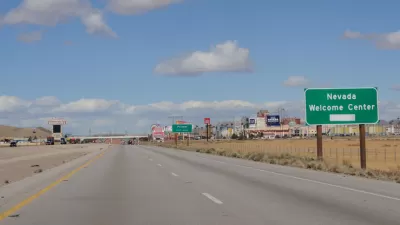If California is going to meet the new, steep emissions reductions required by a law passed last September, one of the most effective strategies will be to promote infill housing, according to a new report from University of California at Berkeley.
On March 28, "a new UC Berkeley study pointed out that building the right kind of new housing — denser housing in urbanized areas near transit — would be one of the best ways for California to meet our 2030 climate goals without sacrificing economic growth," noted a San Francisco Chronicle editorial on the state's notorious housing crisis.
"The report ['Right Type, Right Place: Assessing the Environmental and Economic Impacts of Infill Residential Development through 2030',] is the first comprehensive academic evaluation of the potential economic and environmental impacts of infill housing development on California’s 2030 climate goals under [SB 32], a 2016 law that requires the state to slash greenhouse gas emissions to 40% below 1990 levels by 2030," writes Jennifer Goodman for BUILDER.
“When deciding where to build new homes, infill housing is the smart choice, economically and environmentally,” says F. Noel Perry, businessman and founder of the nonprofit, nonpartisan group Next 10, which commissioned the study.
Next 10 commissioned the Center for Law, Energy and the Environment (CLEE) at UC Berkeley School of Law and the Terner Center for Housing Innovation at UC Berkeley, to conduct the analysis and write the report.
What makes the infill strategy key to meeting SB 32 goals is the reduction in driving that results from infill housing, particularly when sited by transit.
"A shift toward infill housing, to be built within three miles of rail stations, would help avert at least 1.79 million metric tons of greenhouse gas emissions annually, according to the report," writes Richard Scheinin, residential real estate reporter for the Bay Area News Group. "That’s the equivalent of eliminating emissions from 378,108 passenger vehicles, or not burning more than 201 million gallons of gasoline annually, the report says."
However, as posted here upon the passage of SB 32 last September, "Anyone can put lofty climate goals on paper," wrote Brad Plumer for Vox. "The real question is whether California can undertake the specific actions needed to actually cut emissions."
On that note, Scheinin adds, "Of course, for the infill shift to happen, there would first need to be a significant shift in public policy — and overcoming the objections of homeowners who value traditional neighborhoods filled with single-family homes."
One such approach to overcoming those objections may present itself in the form of new "streamlining" legislation, SB 35, by Sen. Scott Wiener (D-S.F.), which was last amended on April 4.
The aforementioned Chronicle editorial ended with an endorsement of Wiener's bill and a quote from its author:
The Legislature is considering some 130 bills related to the housing crisis this session. What distinguishes SB35 is that it’s based on the same principle as Gov. Jerry Brown’s “by-right” proposal from last year: Since local governments have too often said no to new housing development, the state has to help them find ways to say yes.
“Adding more infill housing is absolutely essential to combatting climate change and keeping our middle class housed,” Wiener said.
Related in Planetizen:
Report: California Should Treat Housing Crisis like Climate Change, January 1, 2017: The California Apartment Association released a report on what it will take to solve the state's chronic housing shortage. Cities that are loath to permit new residential developments, both affordable and market rate, will not be pleased.
Hat tip to Darrell Clarke.
FULL STORY: Report: Infill Is Key To California's Future

Study: Maui’s Plan to Convert Vacation Rentals to Long-Term Housing Could Cause Nearly $1 Billion Economic Loss
The plan would reduce visitor accommodation by 25,% resulting in 1,900 jobs lost.

Alabama: Trump Terminates Settlements for Black Communities Harmed By Raw Sewage
Trump deemed the landmark civil rights agreement “illegal DEI and environmental justice policy.”

Why Should We Subsidize Public Transportation?
Many public transit agencies face financial stress due to rising costs, declining fare revenue, and declining subsidies. Transit advocates must provide a strong business case for increasing public transit funding.

Paris Bike Boom Leads to Steep Drop in Air Pollution
The French city’s air quality has improved dramatically in the past 20 years, coinciding with a growth in cycling.

Why Housing Costs More to Build in California Than in Texas
Hard costs like labor and materials combined with ‘soft’ costs such as permitting make building in the San Francisco Bay Area almost three times as costly as in Texas cities.

San Diego County Sees a Rise in Urban Coyotes
San Diego County experiences a rise in urban coyotes, as sightings become prevalent throughout its urban neighbourhoods and surrounding areas.
Urban Design for Planners 1: Software Tools
This six-course series explores essential urban design concepts using open source software and equips planners with the tools they need to participate fully in the urban design process.
Planning for Universal Design
Learn the tools for implementing Universal Design in planning regulations.
Smith Gee Studio
Alamo Area Metropolitan Planning Organization
City of Santa Clarita
Institute for Housing and Urban Development Studies (IHS)
City of Grandview
Harvard GSD Executive Education
Toledo-Lucas County Plan Commissions
Salt Lake City
NYU Wagner Graduate School of Public Service




























